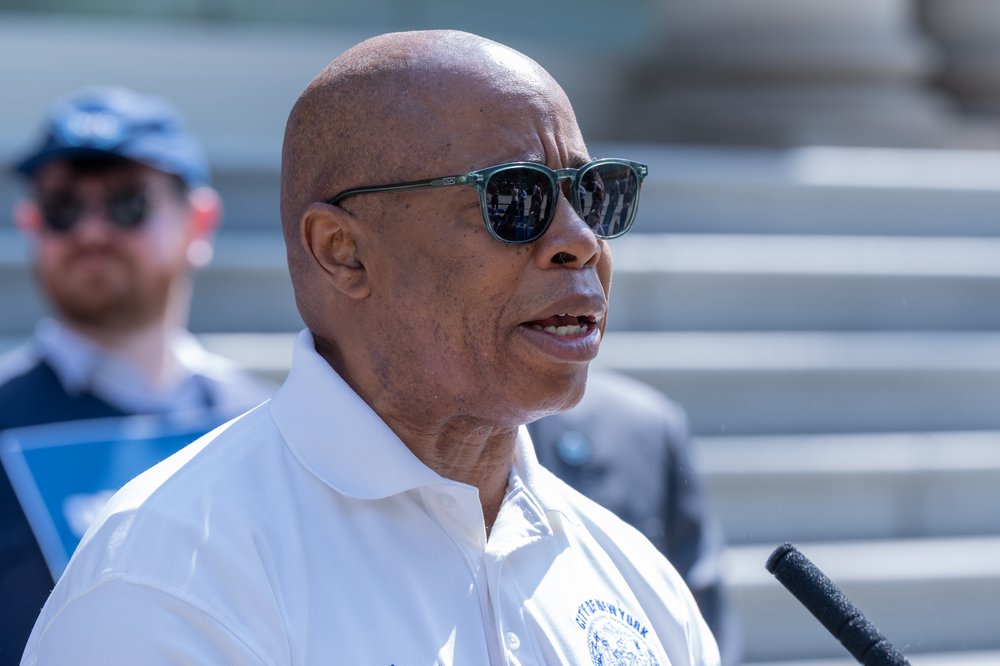Mayor Adams unveils new NYC plan to build more 2-bedroom apartments for seniors
July 29, 2025, 1:01 p.m.
The city’s housing agency will require developers to build “family-sized” senior housing in neighborhoods where affordable apartments are scarce.

It’s a familiar problem for many New York City apartment-hunters: The places they can actually afford are too small for their families, forcing them to hang partitions in living rooms, lay mattresses on floors, and cram into one-bedrooms and studios.
Now the city’s housing agency is reconfiguring one of its key programs for getting low-income seniors into affordable housing to develop more two-bedroom units, and potentially help address a deep shortage of apartments for low-income families.
The Department of Housing Preservation and Development issued a new rule this month that requires developers to include two bedrooms in at least 20% of their new units to qualify for the Senior Affordable Rental Apartments, or SARA, program in certain neighborhoods.
The SARA program funds construction of 100% affordable housing for New Yorkers aged 62 and older who earn no more than $68,000 a year. Under the program, nearly a third of the units must be reserved for individuals and families leaving homeless shelters, but none of the 7,322 apartments built through the program since 2014 have more than one bedroom, according to Housing Preservation and Development data.
In a written statement, Mayor Eric Adams said the program has helped thousands of older adults find homes, but has left out seniors who live with family members or need in-home attendants.
“For too long, our city’s housing policies have made it harder for older adults to live with aides, children or other family members,” Adams said. “With these new rules, we’ll build more senior housing with extra bedrooms and help more families find an affordable place to live together in New York City.”
Adams and city housing officials point to a review of housing data published last year that found nearly a third of older adults in New York City live with their children.
Under to the new rules, the 20% two-bedroom requirement would apply to new buildings in so-called limited affordability areas — sections of the city, like much of Staten Island, Central and Eastern Queens, and Manhattan's East Side, that have produced very few new units of affordable housing for the lowest-income New Yorkers. Outside those areas, developers can now choose to add two-bedroom units to their low-income senior buildings and still qualify for the SARA funding.
The concentration of studios and one-bedrooms in the senior housing built under the program reflects a larger trend in New York City’s efforts to build low- and middle-income housing to put a dent in its historic affordable housing shortage.
A Gothamist analysis of city housing data last year found that less than a third of new affordable apartments built since the start of 2022 featured at least two bedrooms. Studios and one-bedrooms made up nearly all of the new affordable units constructed in many parts of the city, like Jamaica, Queens, during that period, the data shows.
Developers and advocates for older adults who spoke with Gothamist say they support the rule change to help create new family-sized housing, and urge the city to provide additional funding for the projects. But they say they also worry it could stall or add new complications to future development.
A 2024 report from advocacy organization LiveOn NY, a coalition of housing groups and service providers, found that 85% of seniors applying for city affordable housing lotteries were single adults or two-person households.
The report also showed that 220,000 older adults have submitted applications for affordable senior apartments through the city’s housing lottery since 2020, the equivalent of 69 applications for every one unit.
Those older applicants tended to have lower incomes than the average housing lottery user, according to the report. Roughly 57% of households with at least one senior member who applied for apartments through the lottery reported being “extremely low-income” — meaning a single adult who earns no more than $34,000 as well as a family of four earning less than $49,000 — compared to 38% without an older adult.
“Ultimately, we support the city’s efforts to create better living conditions for older adults so they can age in place with the supports they need,” LiveOn NY Public Policy Director Kevin Kiprovski said. “We continue our calls to ensure we increase funding to meet the incredibly large need for housing.”
LiveOn NY also recommends the city set definitive targets for deeply affordable senior housing development, with a goal of at least 1,000 units per year. During the fiscal year that ended last month, the city funded 336 new units through the SARA program.
Jenna Breines, the director of real estate at the nonprofit West Side Federation for Senior and Supportive Housing, said the new rule could address an important need for seniors and their families.
But Breines, who previously oversaw the senior housing program at the Department of Housing Preservation and Development under former Mayor Bill de Blasio, said the city should ensure the two-bedroom rule doesn’t interfere with current construction plans or make new affordable housing more expensive to build.
“It’s an interesting concept and interesting policy,” Breines said. “I hope the housing department can figure out a way to be flexible so that all available housing sites can still be utilized and that it doesn’t take some sites off the table.”
Bronx landlord fined $10 million for ‘unsafe’ apartment building From abandoned Queens hospital to affordable housing, despite federal funding cuts Cuomo called 'Freeze the Rent' pandering. Now, he wants the city to ‘increase’ regulations.